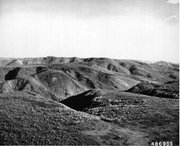Upper Yukon Tayga - Meadow Province
Contents
Upper Yukon Tayga - Meadow Province (Bailey)
Kokrine-Hodzana highlands, Yukon-Tanana upland, Porcupine Plateau, 68,400 mi2 (177,200 km2)
Land-surface form
This province is composed of rounded low mountains rising to 2,000-4,000 ft (600-1,200 m) in altitude, along with plateaus and highlands of rolling topography and gentle slopes interspersed with frequent valleys. They are underlain by a very complex geologic matrix of metamorphic, igneous, and sedimentary rocks. There are no glaciers. Isolated peaks, mostly near the Canadian border, rise to heights of 5,500-6,000 ft (1,700-1,800 m).
Climate
The area has an extreme continental boreal climate with a large annual temperature range, severely cold winters, and short, hot summers. Temperatures average from about 10 to 16F (-12 to -9C) in the north and 19 to 25F (-7 to -4C) at lower elevations in the south. Average annual precipitation ranges from 10 to 15 in (260 to 380 mm); precipitation is heaviest in late summer. Average snowfall ranges from 47 to 98 in (1,200 to 2,500 cm).
Vegetation
The vegetation pattern in the area is complex. Forests of white spruce, paper birch, and quaking aspen cover most lower slopes in the south and southfacing slopes in the north. Black spruce forest vegetation grows at higher elevations, on all northfacing slopes in the south, on all but steep southfacing slopes in the north, and on lower slopes with impeded soil drainage throughout the area. Above the black spruce forest, the vegetation is alpine meadow characterized by sedges on poorly drained sites and by low-growing shrubs on drier sites.
Soils
The dominant soils are Inceptisols. The entire area is underlain by discontinuous permafrost.
Fauna
Caribou and introduced bison inhabit the area, and Dall sheep are found in the high mountains. Upland furbearers, such as marten, mink, and shorttail and least weasels, are common. Hoary marmots populate mountainous areas, and woodchucks are found in the lower open woodlands. There is prime habitat for arctic ground squirrels and northern flying squirrels. The range of the longtail and yellow-cheeked voles in interior Alaska corresponds closely to this region.
The open mixed deciduous-conifer forests of the area support a large variety of birds. Common breeding birds include gray jays, boreal chickadees, northern flickers, red-tailed hawks, and boreal owls.
Return to Ecoregions of the United States
| Disclaimer: This article is taken wholly from, or contains information that was originally published by, the United States Forest Service. Topic editors and authors for the Encyclopedia of Earth may have edited its content or added new information. The use of information from the United States Forest Service should not be construed as support for or endorsement by that organization for any new information added by EoE personnel, or for any editing of the original content. |
